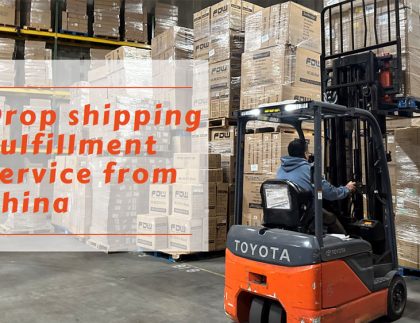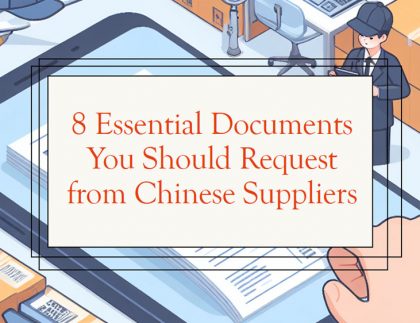10 Common and Important Documents for International Shipping
What documents do you need when shipping internationally shipment ? Learn about what you may need to have for your international shipping efforts.

International shipping is the process of sending goods from one country to another by sea, air, or land. International shipping can be a complex and challenging task, as it involves various regulations, customs procedures, and documentation requirements.
At DIDADI Logistics, we’ve spent more than 13years helping customers ship their cargo internationally and understand the challenges that come with it.
In this blog post, I will explain 10 of the most common and important documents that you need to prepare for international shipping.
#1: Commercial Invoice
A commercial invoice is a critical document used in international trade and commerce. It serves as a legal record of the sale of goods between a seller (exporter) and a buyer (importer).
This document provides detailed information about the goods being shipped, including their description, quantity, value, and other important information.
Commercial invoices are typically required for customs clearance and are used by customs officials to assess duties and taxes on imported goods.
#2: Packing List
A packing list, also known as a bill of parcel or shipping list, is a document that accompanies a shipment of goods. It provides a detailed list of the contents of the shipment, including information about the items, their quantity, and their packaging.
A packing list is typically used in conjunction with other shipping documents, such as a commercial invoice and a bill of lading, to ensure accurate and efficient handling of goods during transit.
#3: Bill of Lading
A Bill of Lading (B/L) serves as a crucial piece of documentation that details the shipment of goods from the shipper (the person or entity sending the goods) to the consignee (the person or entity receiving the goods).
Bill of Ladings are commonly used in ocean freight, but they can also be used in other modes of transportation, such as air or truck freight.
Bill of Ladings serve several important purposes:
- Receipt of Goods: They act as a receipt for the shipper, confirming that the goods have been accepted for shipment by the carrier.
- Title of Ownership: In some cases, the Bill of Lading serves as a title of ownership, allowing the consignee to claim the goods upon arrival.
- Contractual Agreement: They serve as a contractual agreement between the shipper and the carrier, outlining the terms and conditions of the shipment.
- Documentary Evidence: Bill of Ladings can be used as evidence in disputes, insurance claims, or legal matters related to the shipment.
- Customs and Trade Documentation: They are essential for customs clearance and trade documentation in international shipping.
#4: Air Waybill
An Air Waybill (AWB) is a crucial document used in airfreight and international logistics to facilitate the transportation of goods by air.
It serves as both a contract of carriage and a receipt for the shipper, documenting the details of the air cargo shipment and outlining the terms and conditions of transportation.
AWBs are issued by airlines or airfreight forwarders and are used extensively in the global air cargo industry.
#5: Certificate of Origin
A Certificate of Origin (COO) is a document issued by an authorized organization or authority that certifies the origin of goods. It is used in international trade to provide information about the source or country of manufacture of a particular product.
The COO is an important document because it can affect trade agreements, import duties, and other customs and trade-related regulations.
Types of Certificates of Origin
- Non-Preferential COO: This type of certificate is used for goods that do not qualify for preferential treatment under trade agreements. It simply states the origin of the goods without any special trade benefits.
- Preferential COO: This type of certificate is used for goods that qualify for preferential treatment under trade agreements, such as free trade agreements or regional trade blocs. These agreements often reduce or eliminate import duties for goods originating from member countries.
Information on the Certificate
- Details of the exporter and importer.
- Description of the goods (e.g., product name, quantity, value).
- Country of origin.
- Date of issuance.
- Date of issuance.
#6: Export License
An export license is a government-issued authorization that permits a person or business to export certain goods or technologies from one country to another.
These licenses are a crucial component of export control measures that governments implement to regulate the flow of specific items that could have security, economic, or foreign policy implications.
Export licenses are typically required for items that are deemed sensitive, restricted, or subject to export controls.
#7: Import License
An import license is a government-issued document or authorization that grants permission to individuals or businesses to import specific goods or commodities into a country.
Import licenses are used by governments to regulate the inflow of certain products, control imports for various reasons, and ensure compliance with trade regulations and customs procedures.
The requirements for obtaining an import license, as well as the types of goods that require one, can vary significantly from one country to another.
#8: Shipper’s Letter of Instruction
A Shipper’s Letter of Instruction (SLI) is a document provided by the shipper (usually the exporter or their authorized agent) to the freight forwarder or carrier when arranging the transportation of goods for international shipping.
This letter of instruction serves as a set of guidelines and details for the freight forwarder or carrier, outlining how the shipment should be handled and transported.
It helps ensure that the goods are prepared, documented, and transported correctly and in compliance with all relevant regulations.
#9: Insurance Certificate
An insurance certificate, often referred to as a Certificate of Insurance (COI), is a document issued by an insurance company or agent that provides proof of insurance coverage. This certificate is typically provided to a policyholder or a third party to confirm the existence of an insurance policy and to detail its key terms and conditions.
Insurance certificates are commonly used in various contexts to demonstrate that insurance coverage is in place for specific purposes.
#10: Dangerous Goods Declaration
A Dangerous Goods Declaration (DGD) is a document required in international shipping and transportation to provide detailed information about hazardous materials or dangerous goods being transported. This declaration is an essential part of ensuring the safe handling, transportation, and compliance with regulations governing the shipment of hazardous materials.
The Dangerous Goods Declaration is a critical document for ensuring the safety of people and the environment during the transportation of hazardous materials.
It is required by various international and national regulations, including those set forth by organizations like the International Maritime Organization (IMO), the International Air Transport Association (IATA), and the United Nations.
Conclusion
These are 10 of the most common and important documents that you need for international shipping. Of course, there may be other documents that are required depending on your specific situation and requirements.
For international orders, DIDADI offers the opportunity to leverage our extensive global fulfillment network, allowing you to stock inventory in countries near your international customers. This streamlined approach reduces the requirement for extra documentation when fulfilling orders for international clients.
Moreover, DIDADI Logistics is equipped to assist you in efficiently handling the shipment of hazardous materials within your domestic operations. You can simply designate the item as “Dangerous Goods” on our platform, enabling us to implement the necessary safety measures when processing the order.
Start your ship now!
- Improve your cross-border shipping
- Decrease expenses
- Accelerate deliveries









